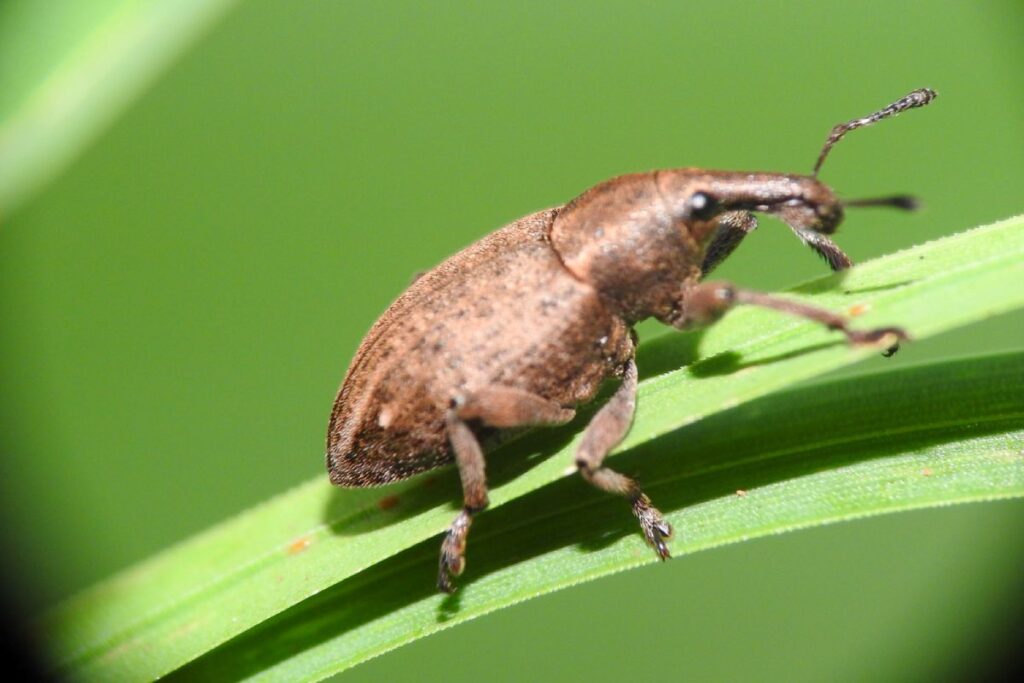Say goodbye to pesky bugs with the secret weapon hidden in your kitchen (or garden). Known for their distinct aroma, bay leaves have long been believed to repel most bothersome bugs.
I’ve been growing bay leaves for many moons! And there is evidence that bay leaves repel the following seven common bugs:
- Roaches
- Moths
- Ants
- Weevil
- Flies
- Silverfish
- Bed bugs
In this post, I’ll take a look at:
- The seven bugs that bay leaves repel
- Some practical tips to use bay leaves to repel bugs
- Benefits and limitations of using bay leaves as a bug repellant
- Additional benefits of bay leaves

7 Common Bugs That Bay Leaves Repel
1. Roaches
According to exterminators, the peppery smell of bay leaves deters roaches. The scent disrupts their sensory receptors and discourages them from entering areas with Bay leaves.
Plus, Bay leaves contain essential oils, such as eucalyptol and linalool, and are known to be natural repellents and have insect-repelling properties.
2. Moths
Moths are some of the bugs that bay leaves repel.
The strong fragrance of bay leaves repels moths. Placing bay leaves where moths are likely found, such as in closets or storage containers, can help deter them from laying eggs or infesting fabrics.
3. Ants
Bay leaves emit a scent that disrupts the trails of pheromones that ants use to communicate and navigate. This disruption confuses ants and deters them from entering areas with bay leaves.
In addition, bay leaves have volatile compounds that are released into the air. These compounds interfere with the ant’s ability to detect food or establish thor colonies.
4. Weevil
Similar to the other bugs above, the sharp odor of bay leaves repels weevils, making them less likely to infest stored grains and cereals.
Bay leaves are a common natural repellant used against weevils. All you have to do is put Bay Leaves in grain and flour containers to keep bugs away.

5. Flies
Some sources claim that bay leaves can help deter flies, but their effect can be limited.
Despite the limited impact, the sharp aroma of bay leaves repels flies, making them less likely to linger or infest certain areas.
Additionally, fly traps and proper sanitation is needed for comprehensive fly control.
6. Silverfish
Bay leaves are occasionally mentioned as a repellent for silverfish. Although Bay leaves ability to repel silverfish is unclear, it is believed that the peppery odor of bay leaves may discourage silverfish from inhabiting areas with bay leaves.
Controlling humidity levels, sealing cracks, and removing potential food sources are also essential for managing silverfish infestations effectively.
7. Bed Bugs
Bay leaves are sometimes suggested to repel bed bugs, but their effectiveness in eliminating or preventing bed bug infestations is limited.
Professional pest control methods are typically necessary for effective bed bug management.
Furthermore, thorough cleaning, vacuuming, and treatment by a licensed exterminator are crucial in dealing with bed bug infestations.
Practical Tips to Use Bay Leaves to Repel Pests
While there’s still no established scientific research on how bay leaves can repel pests, here are some practical tips that you could do in your home:
- Place bay leaves in kitchen cabinets, pantry shelves, or storage containers to repel roaches and weevils.
- Leave bay leaves in closets, drawers, or garment bags to deter moths from infesting clothing or fabrics.
- Position bay leaves near windows, doors, or outdoor areas to discourage flies from entering your home.
- Put bay leaves where silverfish are commonly found, such as in bathrooms or basements, to deter their presence.
- Consider using bay leaves with other pest control methods for comprehensive bug management.
- Replace bay leaves periodically since their effectiveness may diminish over time.
- Be cautious if using bay leaves in areas accessible to pets or children, as ingestion can be harmful. Keep them out of reach or use alternative pest control methods.
- Proper sanitation, cleanliness, and storage practices are essential for effective pest control.
Benefits and Limitations of Using Bay Leaves as a Bug Repellent
Bay leaves have several properties that could impact the effectiveness of repelling bugs. Here’s a table that summarizes the benefits and limitations of using bay leaves as a bug repellent:
| Benefits of Using Bay Leaves as a Bug Repellent | Limitations and Considerations |
| Natural and non-toxic repellent | Effectiveness may vary for different bugs and infestation levels. |
| Aromatic fragrance provides a pleasant scent in living spaces | Limited scientific research on its bug-repelling properties |
| Affordable and easily accessible | Additional pest control measures may be necessary for severe infestations. |
| Versatile usage in various areas prone to bug infestations | Bay leaves need to be replaced periodically for sustained effectiveness. |
| Potential eco-friendly alternative to chemical insecticides | Some individuals may be allergic to bay leaves or their aromas. |
Additional Benefits of Bay Leaves
Aside from their bug-repelling properties, bay leaves offer additional benefits. Here are a few:
- Culinary Uses: Bay leaves enhance soups, stews, sauces, and other dishes.
- Digestive Aid: Bay leaves soothes the digestive system and alleviate bloating and gas.
- Anti-inflammatory Properties: Eugenol in bay leaves relieves arthritis and inflammatory bowel disease.
- Antioxidant Properties: Antioxidants in bay leaves support heart health and reduce chronic disease risk.
- Respiratory Health: Using bay leaves can relieve respiratory congestion and promote healthy breathing.
Conclusion
Bay leaves, nature’s bug-repelling secret, provide a natural and non-toxic option for keeping pests at bay. From roaches and moths to ants and weevils, bay leaves have been associated with deterring these pesky intruders.
While bay leaves may not be a guaranteed solution, they can play a valuable role in your bug management arsenal. Pairing bay leaves with good sanitation practices, regular cleaning, and proper storage techniques forms a powerful defense against unwanted critters.
Remember to exercise caution when using bay leaves in areas accessible to pets or children to avoid any potential harm.

